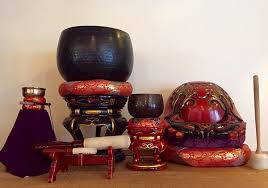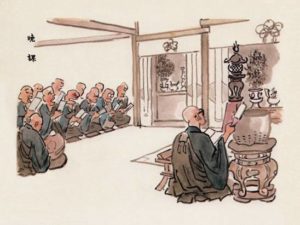During Ango (practice period), in the morning we practice with more zendo forms than usual. The ‘extra’ sounds and movements help evoke a focused attention and one-body sangha practice. Below is a guide to these forms. Questions may be directed to either Bruce (our Ino- Head of the Meditation Hall) or Choro (our Tanto – Head of Practice)
The han (wooden block) begins 10 min. before zazen begins. Please try to be online and settled in your seat by the end of the second roll-down (i.e. 2 minutes before zazen is scheduled to begin).
 After the han ends, the large and small bells you hear are the sounds of the zazen period formally being ‘opened’. When in the zendo in-person together, this is when the doshi (officiating priest) is making an incense offering, 3 prostrations, and doing a ‘morning greeting’ by walking around the zendo. The three small bells at the end of this part signal the start of formal zazen.
After the han ends, the large and small bells you hear are the sounds of the zazen period formally being ‘opened’. When in the zendo in-person together, this is when the doshi (officiating priest) is making an incense offering, 3 prostrations, and doing a ‘morning greeting’ by walking around the zendo. The three small bells at the end of this part signal the start of formal zazen.
Next, the time drum begins. The pattern is one drum hit for each hour, and a small bell for each 20 min. increment of the hour. So you will hear six drum strikes and one small bell for 6 a.m. + a few minutes past 6. This is repeated three times. In monasteries no watches are worn and the drum communicates the time.
Near the end of second period of zazen, the time drum is played again. This time you’ll hear 7 strikes & one small bell. As soon as the third round of the time-drum ends, the han begins. There are three rounds: the first is 7 strikes and a roll-down ending with one hit, then 5 strikes and a roll-down ending with two hits. The two hits signal everyone with rakusu (or okesa) to put their robe on their heads & wait in gassho through the final round of 3 strikes, rolldown and three hits. Then we chant the Robe Chant together, which is accompanied by strikes on the densho (hanging bell), and as we say “saving all beings” you will hear a roll-down on the densho ending in one ring. Bow while seated, and put on your robe if you have one.
 For service:
For service:
you may stand or remain seated. [NB during a long service in the zendo, with 9 floor bows, we would sit down to chant, but this service is a hybrid: nine prostrations, repentance, refuges, and then just one chant. It’s fine to stand and remaining standing, or sit and remain sitting, or some combination, for this service.)
When service begins you will hear the small bell struck three times, followed by a rolldown. Place your hands in gassho at the start of these bells. Then there are 9 big bells for 9 bows – full prostrations, standing bows, or seated bows – and remain in gassho. There is a ‘stop’ or clunk sound in between the bells that is the signal to come back up and get ready to bow again. You should stay down until you hear this ‘clunk’. The ninth bell will be signaled with a second hit, instead of a stop. After completing these bows, do a small standing bow.
Chanting the Repentances and Refuges: stand or sit in gassho to chant.
We chant three rounds of repentance (no bells) followed by chanting the refuges; for each of these, there is a big bell followed by a small bell. The small bell marks when we bow (at the words “before all beings”). A second small bell indicates when to come back up.
Currently we are chanting either the Shingyo (Heart Sutra in Japanese) or English version of Heart Sutra. You may chant either from a seated or standing position. Keep your hands in shashu for the chanting (except when chanting the Hymn to the Perfection of Wisdom on Saturday mornings, when hands are kept in gassho). A link to the texts for morning service during this practice period is here.
The dedication is to our Zen ancestors, and we bow when the kokyo (chant leader) raises their voice “our great original teacher…” and remain in the bow until “Manjushri”. Then, during the final “All Buddhas, Ten Directions…” our hands are again in gassho. When you hear the small bell roll-down at the start of the second line, “Wisdom beyond wisdom”, it means we are preparing to offer the final 3 prostrations. Again, this may be done from standing or sitting.
After service there are two bells: for the first, we gassho bow to the altar (in the zendo); for the second, we shashu bow to each other. The last two bells in quick succession indicate when the doshi has exited the zendo and service is over. Do a standing shashu bow with these bells.
Share this:
- Click to email a link to a friend (Opens in new window) Email
- Click to share on Facebook (Opens in new window) Facebook
- Click to share on Telegram (Opens in new window) Telegram
- Click to share on Bluesky (Opens in new window) Bluesky
- Click to share on X (Opens in new window) X
- Click to share on LinkedIn (Opens in new window) LinkedIn
